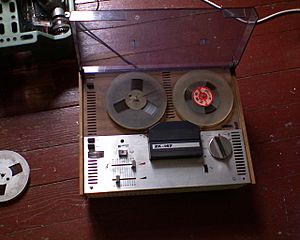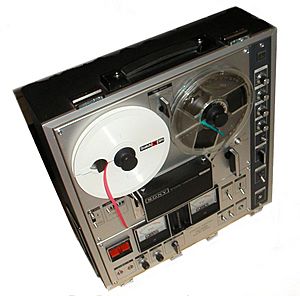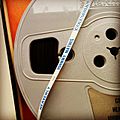Reel-to-reel tape recorders facts for kids
Reel-to-reel tape recorders are cool old machines that were used a lot in the 20th century. People often called them R2R or open reel decks. They started in professional studios in the 1940s and quickly became popular in homes during the 1950s and 1960s.

Their biggest time was in the 1970s. This was probably because people wanted really good quality recordings. This technology was a big deal! It let everyone record any sound they wanted, like vinyl records, radio shows, voices, and music. You could play these recordings many times without the sound getting worse, and you could even record over them again and again.
Even though they were big and a bit delicate, reel-to-reel recorders had some special advantages over today’s digital media formats. Some famous bands and artists even used them as a musical instrument or as a separate part of their band!
Contents
How Reel-to-Reel Recorders Work
These special machines are usually analogue sound devices. They use a magnetic tape that is about a quarter of an inch (6.25 cm) wide. This plastic tape is covered with a special magnetic material. When you record, tiny parts of this material become like tiny magnets, holding the sound information.
A tape recorder needs special parts called "heads" to work. It has a record head, a playback head, and an erase head. These heads transfer the sound signal onto the tape. More expensive recorders might have three or even six separate heads for better sound.
Tape recorders combine amazing mechanics and electronics. They need very precise motors and moving parts to handle the tape smoothly. They also have a complicated circuit board inside, with transistors and amplifiers that help process the sound.
Common Functions
Tape recorders have several basic functions, just like a modern music player:
- Playback (play)
- Stop
- Rewind
- Fast forward
- Pause
These functions can be controlled in two ways:
- Mechanically: Using a system of rubber belts and metal levers.
- Electronically: Using magnets, coils, and integrated circuits.
Tape Speed and Playback Time
The speed at which the tape moves past the heads is very important. It affects how long you can record and how good the sound quality will be. Faster speeds usually mean better sound quality but less recording time on one reel.
Here’s a table showing different tape speeds and how much playback time you get with a typical 18 cm reel:
| Tape speed (cm/s) | Description | Playback time (min) |
|---|---|---|
| 9.52 | Good enough quality | 128 |
| 19.05 | Standard quality for home use | 64 |
| 38.10 | High quality, almost professional | 32 |
| 76.20 | Professional studio quality | 16 |
Major Brands
Many companies made reel-to-reel tape recorders when they were popular. Some of the most well-known brands included Sony, Akai, Revox, Teac, Pioneer, and Technics. These companies often had different product lines, offering various prices and features.
The best models had cool features like digital counters to track tape position, automatic reverse (so you didn't have to flip the tape), and electronic buttons. They could also use very large reels, up to 26.5 cm in size. There were also many companies that made the magnetic tapes themselves, such as Maxell, Basf (now Emtec), Quantegy, and Agfa.
Reel-to-Reel Recorders in Czechoslovakia
In Czechoslovakia, one of the most important producers of tape recorders was Tesla, n.p. The main ideas and designs came from Tesla in Pardubice, while the actual making of the machines happened in Tesla Přelouč. They made thousands of units and many different models.
One very popular model was the Tesla Sonet Duo (made in 1959). It was small, portable, and very dependable. Many collectors agree that the Tesla B73 Hi-Fi Stereo (from 1978) was probably the most advanced model. It set the stage for later designs. The very best models, like the Tesla B115, B116 (1981), and Tesla CM130, CM160 (1986), could even compete with similar machines made by big international companies. However, due to some restrictions at the time, not all the best ideas could be used. Production of these machines ended in 1990 as newer technologies took over.
Images for kids








